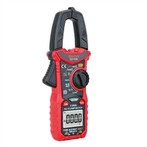A Method for Detecting the Quality of Thermistors with a Multimeter
The purpose of measuring thermistors is to measure their resistance and accuracy.
When conducting the test, use a multimeter ohm range, which is divided into two steps: first, perform a room temperature test, and use a crocodile clamp instead of a probe to clamp the two pins of the PTC thermistor to measure its actual resistance value. Compare the actual resistance value with the nominal resistance value, and the difference between the two is within ± 2 Ω, which is considered normal. If the actual resistance value differs significantly from the nominal resistance value, it indicates poor performance or damage.
Secondly, heating detection. On the basis of normal room temperature testing, the second step of testing can be carried out: heating detection. A heat source is placed close to the thermistor to heat it, and the multimeter indicator is observed. At this time, if the multimeter indicator changes with the increase of temperature, it indicates that the resistance value is gradually changing. When the resistance value changes to a certain value, the displayed data will gradually stabilize, indicating that the thermistor is normal. If the resistance value does not change, it indicates that its performance has deteriorated, Cannot continue to use.
1. Detection of Positive Temperature Coefficient Thermistors
Like most methods of measuring resistance with a multimeter, when using a pointer type multimeter to detect the quality of a positive temperature coefficient thermistor, it is necessary to set the multimeter to R × First gear, the operation steps are divided into two steps. When conducting room temperature testing, first measure the actual resistance value of the two pins of the PTC thermistor that are in contact with the two probes, and compare them with the nominal resistance value. If the difference between the two is within ± 2 Ω, it is considered normal. If the actual resistance value differs significantly from the nominal resistance value, it indicates poor performance or damage.
The heating detection of the thermistor is carried out on the basis of normal room temperature testing. When using the multimeter to measure the resistance as described in the previous section to determine whether the thermistor is normal, the second step of testing can be carried out: heating detection. A heat source is placed close to the PTC thermistor to heat it, and a multimeter is used to monitor whether its resistance value increases with the increase of temperature. If so, it indicates that the thermistor is normal, If the resistance value does not change, it indicates that its performance is not good and cannot be used anymore. At this point, be careful not to place the heat source too close to or directly in contact with the PTC thermistor to prevent it from being burned out.
2. Detection of Negative temperature Coefficient Thermistor
When the resistance measurement technology of multimeter is used to detect the quality of Negative temperature coefficient thermistor, the method is the same as that of measuring ordinary fixed resistance, that is, the real value of Rt can be directly measured by selecting a suitable resistance block according to the nominal resistance value of Negative temperature coefficient thermistor. However, due to the sensitivity of NTC thermistors to temperature, special attention should be paid to several issues during testing:
(1) ARt is measured by the manufacturer at an ambient temperature of 25 ℃, so when measuring Rt with a multimeter, it should also be done when the ambient temperature is close to 25 ℃ to ensure the reliability of the test.
(2) The measured power should not exceed the specified value to avoid measurement errors caused by current thermal effects.
(3) During the test, the thermistor body shall not be held by hand to prevent Human body temperature from affecting the test.
The temperature coefficient of the Negative temperature coefficient thermistor is measured by the resistance measuring technology of the multimeter α When estimating t, first measure the resistance value Rt1 at room temperature t1, and then use an electric soldering iron as a heat source, close to the thermistor Rt, measure the resistance value RT2. At the same time, use a thermometer to measure the average temperature t2 on the surface of the thermistor RT at this time, and then calculate. Only then can the test result be accurate.






